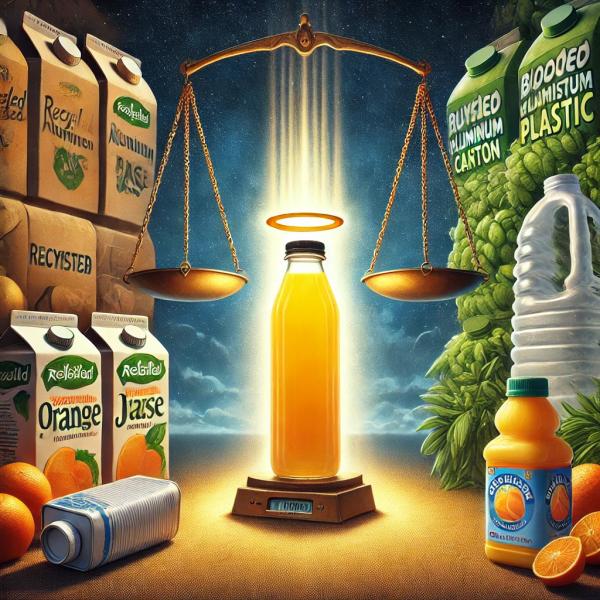
Let’s take a break from the scientific studies considering the nutritional values and health implications of our food and begin with a question about the container; after all, packaging makes up 28% of our landfills, and in addition to its properties in preserving foods it serves as a billboard for advertising a particular food’s virtues.
Which packaging type for a 12-ounce, single-serve container of orange juice would you choose as the most sustainable option:
- Recycled aluminum can
- Biodegradable carton
- 100% recyclable glass
- Biodegradable plastic
Understanding how packaging affects consumer choice was the subject of a study reported in Sustainability. (Read on for the “correct” answer.)
“The objective of the present study is to determine how different packaging types (glass, carton, aluminum, and plastic), along with various price points and common sustainability claims, play a role in consumers’ selection of orange juice [the model product].”
Using an online survey of 847 individuals over age 18 who were drinking OJ at least once a month, the researchers offered a variety of products with varying packaging types and claims, as well as product claims and prices. Packaging could be one of those mentioned in the question, with some being biodegradable, others made from recycled material, and still others 100% recyclable. Price points varied from $1.10 to $2.36 and were offered as locally produced, organic or not from concentrate/100% juice.
According to the respondents, the ideal orange juice option was “packaged in glass, labeled as 100% recyclable, locally produced, and priced at $1.10 per 12 fl. oz.” Unsurprisingly, price was the most important of variables. But let us pause for a moment to consider the preferred packaging, glass. Glass has a bit of a halo here, being considered the most sustainable as well as the safest and healthiest – after all, at one point in the Boomer’s youth, milk was delivered to our homes in glass containers that we returned to be reused. Following what we might consider the standard narrative for sustainability, glass was followed by cartons, aluminum, and then the devil-incarnate, plastic.
Unfortunately, glass’s halo may be undeserved, at least concerning sustainability. Studies across a product's entire life cycle, from manufacture to reuse, show that plastic has 30% less impact on global warming when packaging baby food and 46% less greenhouse gas emissions in healthcare. Plastic transportation costs are less, and “the aseptic sealing process of plastic containers using steam is less energy-demanding than the retort system used for glass.”
You are not alone in being surprised. So was the study’s lead author, Nomzamo N. Dlamini
“I was shocked to read the lifecycle assessment from the experts that it takes so much energy to produce glass and recycle it – much more than what it takes to make or recycle plastic.”
So much for the common narrative.
By offering the participants varying options, the study was designed to understand “what people think and what drives their choices.” As it turns out, the biggest motivator was price or, as Jonathan Lawson would say, “Price, Price, and Price.” The sustainability of packaging was arguably not a significant consideration in a purchasing decision – and when it was, it was based on misinformation about plastic and glass. To channel another advertising great, Sy Syms, “an educator consumer is our best customer.”
It seems, once again, that in considering sustainability, our words signaling our virtue remain disconnected from our actions. As the researchers conclude:
“Overall, while packaging choices contribute to environmental outcomes, the most impactful and practical way consumers can contribute to sustainability efforts is to reduce or avoid food waste.”
Ultimately, while packaging choices play a role in environmental outcomes, the study highlights some of our misconceptions. Perhaps it’s time we shift our focus from the container to the contents and, more importantly, consider how our actions can impact sustainability efforts.
Source: Unpacking Consumer Preferences: Perceptions and Sustainability of Packaging Material for Orange Juice Sustainability DOI: 10.3390/su16146202



